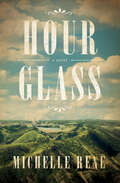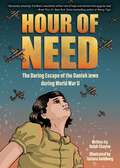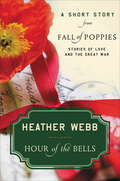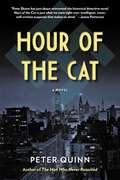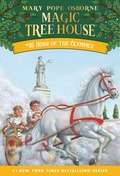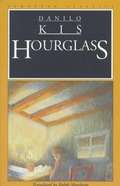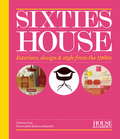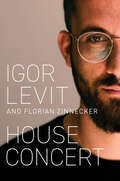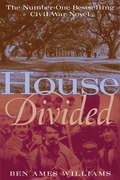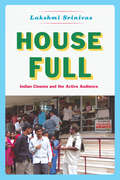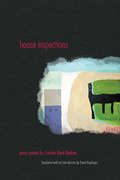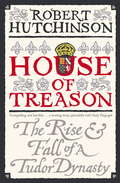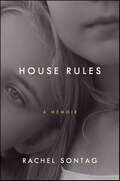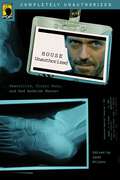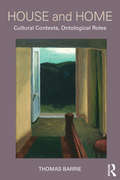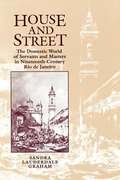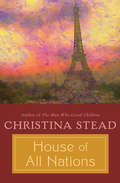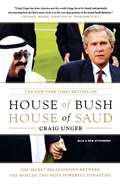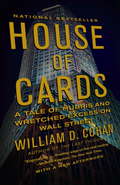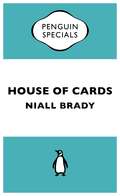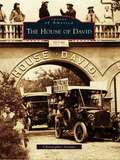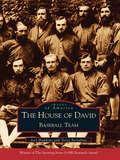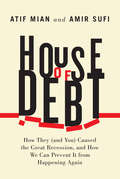- Table View
- List View
Hour Glass: A Novel of Calamity Jane
by Michelle ReneSet in the lawless town of Deadwood, South Dakota, Hour Glass shares an intimate look at the woman behind the legend of Calamity Jane told through the eyes of twelve-year-old Jimmy Glass.After their pa falls deathly ill with smallpox, Jimmy and his sister, Hour, travel into Deadwood to seek help. While their pa is in quarantine, the two form unbreakable bonds with the surrogate family that emerges from the tragedy of loss. In a place where life is fragile and families are ripped apart by disease, death, and desperation, a surprising collection of Deadwood’s inhabitants surround Jimmy, Hour, and Jane. There, in the most unexpected of places, they find a family protecting them from the uncertainty and chaos that surrounds them all.
Hour of Need: The Daring Escape of the Danish Jews during World War II: A Graphic Novel
by Ralph ShayneHour of Need is a graphic novel telling the true story of the Nazi Resistance in Denmark during World War II and the heroes that saved the Danish Jews by helping them evacuate to Sweden.In the Hans Christian Anderson fairy tale, legend had it that should danger ever come to Denmark, the mighty warrior Holger Danske promised to wake from his centuries-long slumber to protect its citizens.When the Nazis move to round up young Mette and her fellow Danish Jews in a surprise raid in 1943 after years of letting Denmark rule its people, her father must make life and death decisions to save his family. Overnight, they have become refugees at the mercy of the complete strangers they meet during their escape. The mythical Holger Danske's promise to the Danish people manifests in the compassion and bravery of a school teacher turned resistance leader and other ordinary citizens who bravely defy the Nazi regime to come to her rescue in her hour of need.Told from the point of view of Mette returning to Denmark years later with her grandchildren, Hour of Need tells the story of how the people of an occupied nation--from king to fisherman--risked their lives to evacuate their Jewish countrymen to Sweden in small fishing boats. Hour of Need is a tribute to the heroes that saved the Danish Jews and how humanity triumphs in the darkest hours.Developed in partnership with the Illinois Holocaust Museum and Education Center. Find out more at ilholocaustmuseum.org.
Hour of the Bells: A Short Story from Fall of Poppies
by Heather WebbIn this breathtaking short story, Heather Webb, the acclaimed author of Becoming Josephine, explores the heartbreak and devotion of a mother searching for peace in war-torn France. Madame Beatrix Joubert has lived her life by the rhythm of the clocks, the call of a cuckoo bird, and the gongs of bells. These once comforting sounds, accompanied by the laughter of her husband and son, now only remind her of the emptiness of her home and the anger that grows inside her. Of German birth, she is an outcast in her French village, but her homeland is the enemy that stole all she held dear. As she plots and plans, fueled by grief and the need for revenge, Beatrix will embark on upon a dangerous journey that could forever alter the life she once knew. Originally published in the moving collection Fall of Poppies: Stories of Love and the Great War, this e-book also includes an excerpt from Webb’s latest novel, Rodin’s Lover, available now.
Hour of the Cat (The Fintan Dunne Trilogy)
by Peter QuinnIt’s just another murder, one of the hundreds of simple homicides in 1939: A spinster nurse is killed in her apartment; a suspect is caught with the murder weapon and convicted. Fintan Dunne, the P.I. lured onto the case and coerced by conscience into unraveling the complex setup that has put an innocent man on Death Row, will soon find that this is a murder with tentacles which stretch far beyond the crime scene . . . to Nazi Germany, in fact; following it to the end leads him into a murder conspiracy of a scope that defies imagination. The same clouds are rolling over Berlin, where plans for a military coup are forming among a cadre of Wehrmacht officers. Admiral Wilhelm Canaris, head of the Military Intelligence, is gripped by a deadly paralysis: He is neither with the plotters nor against them. Joining them in treason would violate every value he holds as an officer. Betraying the plotters to the Gestapo Chief, Reinhard Heydrich, might just forsake the country’s last hope to avert utter destruction and centuries of shame. Heydrich is suspicious. With no limits to Hitler’s manic pursuit of territorial expansion, with crimes against the people candy-coated as racial purification, the “hour of the cat” looms when every German conscience must make a choice. When Canaris receives an order to assist in a sinister covert operation on foreign shores, his hour has come. Hour of the Cat is a stunning achievement: tautly suspenseful, hauntingly memorable, and brilliantly authentic.
Hour of the Olympics
by Mary Pope Osborne Sal MurdoccaThe #1 bestselling chapter book series of all time celebrates 25 years with new covers and a new, easy-to-use numbering system! No girls allowed at the Olympic Games! That's the rule when the Magic Tree House whisks Jack and Annie back to ancient Greece. But when Annie tells jack to go to the games without her, he knows she's up to something. Will Annie find a way to see the games? Or will she get herself—and Jack—into Olympic-size trouble? Find out in Hour of the Olympics. Did you know that there’s a Magic Tree House book for every kid? Magic Tree House: Adventures with Jack and Annie, perfect for readers who are just beginning chapter books Merlin Missions: More challenging adventures for the experienced reader Super Edition: A longer and more dangerous adventure Fact Trackers: Nonfiction companions to your favorite Magic Tree House adventures Have more fun with Jack and Annie at MagicTreeHouse.com!
Hour of the Olympics (Magic Tree House #16)
by Mary Pope Osborne Sal MurdoccaJack and Annie are ready for their next fantasy adventure in the bestselling middle-grade series--the Magic Tree House! No girls allowed at the Olympic Games! That's the rule when the Magic Tree House whisks Jack and Annie back to ancient Greece. But when Annie tells jack to go to the games without her, he knows she's up to something. Will Annie find a way to see the games? Or will she get herself--and Jack--into Olympic-size trouble? Find out in Hour of the Olympics. Visit the Magic Tree House website! MagicTreeHouse.com. From the Trade Paperback edition.
Hourglass
by Ralph Manheim Danilo KisThe novel, Hourglass, by Danilo Kis was translated into English, the Serbo-Croatian, by Ralph Manheim. Danilo Kis was one of the most artful and eloquent writers of postwar Europe. Of all his books, Hourglass, the account of the final months in one man's life before he is sent to a concentration camp, is generally considered to be his masterpiece.
House & Garden Sixties House: Interiors, design & style from the 1960s (House & Garden)
by Catriona Gray House & GardenFrom Pop art to Op art, plastic furniture to bubble-gum paint colours, the Sixties saw a new wave of interior design that was closely linked to popular culture and fashion, becoming increasingly youth-oriented and playful to appeal to the new generation of baby-boomers. In Sixties House, mid-century modern enthusiast Catriona Gray has drawn on the magazine's peerless archive, curating the best illustrations and photographs to show how the use of colour, pattern, homewares and furniture evolved through the decade. The homes of key tastemakers are featured including Bridget Riley, Mary Quant, David Mlinaric, Barbara Hulanicki of Biba and David Bailey. The second title in the new Decades of Design series, House & Garden Sixties House is required reading for mid-century modern enthusiasts, collectors and decorators in search of inspiration from the most influential homes of the past.
House Concert
by Igor Levit Florian ZinneckerIgor Levit ranks among the greatest pianists of his generation, described by The New York Times as &‘one of the essential artists of our time&’. But his influence reaches far beyond music: he uses his public platform to speak out against racism, antisemitism and all forms of intolerance and prejudice. Convinced of the duty of the musician to remain an engaged citizen, he is recognized and admired for his willingness to take a stand on some of the great issues of our day, even though it has come at considerable personal cost. When the pandemic broke out and Levit was unable to give live concerts, he switched his piano recitals from concert halls to his living room and gained a huge international following. This book opens a window onto Levit&’s life during the 2019–2020 concert season, charting the transition from his whirlwind life of back-to-back live concerts in packed concert halls to the eerie stillness of lockdown and the innovative series of house concerts livestreamed over Twitter. A year in which Levit spoke out against hate and received death threats in response. A year in which he found his voice and found himself – as an artist and as a person.
House Divided
by Ben WilliamsFirst published in 1947, this bestselling historical novel is cherished and remembered as one of the finest retellings of the Civil War saga--America's own War and Peace. In the first hard pinch of the Civil War, five siblings of an established Confederate Virginia family learn that their father is the grandfather of Abraham Lincoln. The family's story, and the story of their descendants, is presented in this tale that includes both soldiers and civilians--complete with their boasting, ambition, and arrogance, but also their patience, valor, and shrewdness. The grandnephew of General James Longstreet, the author brings to life one of the most extraordinary periods in history, and details war as it really is--a disease from which, win or lose, no nation ever completely recovers.
House Full: Indian Cinema and the Active Audience (Fieldwork Encounters and Discoveries)
by Lakshmi SrinivasIndia is the largest producer and consumer of feature films in the world, far outstripping Hollywood in the number of movies released and tickets sold every year. Cinema quite simply dominates Indian popular culture, and has for many decades exerted an influence that extends from clothing trends to music tastes to everyday conversations, which are peppered with dialogue quotes. With House Full, Lakshmi Srinivas takes readers deep into the moviegoing experience in India, showing us what it's actually like to line up for a hot ticket and see a movie in a jam-packed theater with more than a thousand seats. Building her account on countless trips to the cinema and hundreds of hours of conversation with film audiences, fans, and industry insiders, Srinivas brings the moviegoing experience to life, revealing a kind of audience that, far from passively consuming the images on the screen, is actively engaged with them. People talk, shout, whistle, cheer; others sing along, mimic, or dance; at times audiences even bring some of the ritual practices of Hindu worship into the cinema, propitiating the stars onscreen with incense and camphor. The picture Srinivas paints of Indian filmgoing is immersive, fascinating, and deeply empathetic, giving us an unprecedented understanding of the audience's lived experience--an aspect of Indian film studies that has been largely overlooked.
House Inspections
by David Keplinger Carsten René Nielsen"These poems do much more than blur the line between illusion and reality: they evoke that vibrant contradiction of dreaming in which the real and unreal exist in perfect simultaneity."--The Georgia Review Theatre A man performs whole days from his life as a drama, each day at home in his apartment. He goes to great lengths to be as realistic as possible, walking around the apartment and tending to day-to-day business. Only at night, when he sits by himself in the kitchen, does he peek now and then at the window to glimpse his audience. He won't completely abandon the notion that someone is out there. It's like when you stand on the landing, in front of a closed door, and you can't help thinking that someone is watching through the peephole. With a dozen poems previously published in The Paris Review, Carsten René Nielsen is already a familiar name to US poetry readers. These dark prose poems--reminiscent of Charles Simic--map out a uniquely European territory with chilling, cinematic clarity. Award-winning Danish poet Carsten René Nielsen is the author of nine books of poetry, including his US debut The World Cut Out with Crooked Scissors (2007). His poems appear in The Paris Review, Agni, Circumference, Mid-American Review, Mississippi Review, and elsewhere. He lives in Aarhus, Denmark. David Keplinger's poetry awards include the Colorado Book Award, T.S. Eliot Prize, an NEA fellowship, and grants from the Danish Arts Council. He directs the MFA program at American University in Washington, DC.
House Inspections (Lannan Translations Selection Series)
by Carsten René Nielsen"These poems do much more than blur the line between illusion and reality: they evoke that vibrant contradiction of dreaming in which the real and unreal exist in perfect simultaneity."—The Georgia Review Theatre A man performs whole days from his life as a drama, each day at home in his apartment. He goes to great lengths to be as realistic as possible, walking around the apartment and tending to day-to-day business. Only at night, when he sits by himself in the kitchen, does he peek now and then at the window to glimpse his audience. He won't completely abandon the notion that someone is out there. It's like when you stand on the landing, in front of a closed door, and you can't help thinking that someone is watching through the peephole. With a dozen poems previously published in The Paris Review, Carsten René Nielsen is already a familiar name to US poetry readers. These dark prose poems—reminiscent of Charles Simic—map out a uniquely European territory with chilling, cinematic clarity. Award-winning Danish poet Carsten René Nielsen is the author of nine books of poetry, including his US debut The World Cut Out with Crooked Scissors (2007). His poems appear in The Paris Review, Agni, Circumference, Mid-American Review, Mississippi Review, and elsewhere. He lives in Aarhus, Denmark. David Keplinger's poetry awards include the Colorado Book Award, T.S. Eliot Prize, an NEA fellowship, and grants from the Danish Arts Council. He directs the MFA program at American University in Washington, DC.
House Of Treason: The Rise And Fall Of A Tudor Dynasty
by Robert HutchinsonKing-makers - Conspirators - Criminals - Nobles - SeducersThe Howard family - the Dukes of Norfolk - were the wealthiest and most powerful aristocrats in Tudor England, regarding themselves as the true power behind the throne. They were certainly extraordinarily influential, with two Howard women marrying Henry VIII - Anne Boleyn and the fifteen-year-old Catherine Howard. But in the treacherous world of the Tudor court no faction could afford to rest on its laurels. The Howards consolidated their power with an awesome web of schemes and conspiracies but even they could not always hold their enemies at bay. This was a family whose history is marked by treason, beheadings and incarceration - a dynasty whose pride and ambition secured only their downfall.
House Rules: A Memoir
by Rachel SontagA memoir of a father obsessed with control and the daughter who fights his suffocating grasp, House Rules explores the complexities of their compelling and destructive relationship as Rachel fights to escape, and, later, to make sense of what remains of her family.
House Unauthorized: Vasculitis, Clinic Duty, and Bad Bedside Manner
by Leah WilsonWhat do you get when you combine CSI science, the medicine of ER, and an acerbic, pain pill addict with a cane? House MD. In House Unauthorized: Vasculitis, Clinic Duty, and Bad Bedside Manner, the entire cast of the show is on the exam table: Wilson, Cuddy, Foreman, Cameron, Chase and particularly the cantankerous, but brilliant Dr. House. What makes House tick? Why did he really hire Foreman, Cameron and Chase (and why is it so easy to believe he's actually subjecting them to some sort of bizarre psychological testing)? What would House be like as a heating and plumbing repairman? And why doesn't Wilson just stop talking to him already? Answers to these questions are presented by a team of writers as talented as the team of doctors in House, MD. The prognosis? One heck of a good read.
House and Home: Cultural Contexts, Ontological Roles
by Thomas BarrieHouse and home are words routinely used to describe where and how one lives. This book challenges predominant definitions and argues that domesticity fundamentally satisfies the human need to create and inhabit a defined place in the world. Consequently, house and home have performed numerous cultural and ontological roles, and have been assiduously represented in scripture, literature, art, and philosophy. This book presents how the search for home in an unpredictable world led people to create myths about the origins of architecture, houses for their gods, and house tombs for eternal life. Turning to more recent topics, it discusses how writers often used simple huts as a means to address the essentials of existence; modernist architects envisioned the capacity of house and home to improve society; and the suburban house was positioned as a superior setting for culture and family. Throughout the book, house and home are critically examined to illustrate the perennial role and capacity of architecture to articulate the human condition, position it more meaningfully in the world, and assist in our collective homecoming.
House and Street: The Domestic World of Servants and Masters in Nineteenth-century Rio de Janeiro
by Sandra Lauderdale GrahamThe Brazilian women of 19th century worked as housemaids either as slaves or free. House and Street re-creates the working and personal lives of these women.
House of All Nations (Miegunyah Modern Library Ser.)
by Christina SteadThe devious world of international finance comes alive in Christina Stead&’s enthralling epic about a ruthless bank director in 1930s ParisPraised as &“a work of extraordinary talent&” by the New York Times, Christina Stead&’s ambitiously layered House of All Nations is an engrossing satire of wealth and manipulation. Set in an elite European bank in the 1930s, Stead&’s epic spans the interwar years of a money-hungry Paris. Jules Bertillon, the distrustful and unpredictable bank director, sees every national disaster—including war—as an opportunity for riches. Adored by his clients for his ability to rake in staggering profits, Bertillon leaves no opening wasted—even if it means dealing with unsavory speculators or ruthless gamblers while his clients suffer the consequences. A stunning page-turner, House of All Nations is as significant and resonant today as it was upon its publication in 1938.
House of Bush, House of Saud: The Secret Relationship Between the World's Two Most Powerful Dynasties
by Craig UngerNewsbreaking and controversial -- an award-winning investigative journalist uncovers the thirty-year relationship between the Bush family and the House of Saud and explains its impact on American foreign policy, business, and national security. House of Bush, House of Saud begins with a politically explosive question: How is it that two days after 9/11, when U.S. air traffic was tightly restricted, 140 Saudis, many immediate kin to Osama Bin Laden, were permitted to leave the country without being questioned by U.S. intelligence? The answer lies in a hidden relationship that began in the 1970s, when the oil-rich House of Saud began courting American politicians in a bid for military protection, influence, and investment opportunity. With the Bush family, the Saudis hit a gusher -- direct access to presidents Reagan, George H.W. Bush, and George W. Bush. To trace the amazing weave of Saud- Bush connections, Unger interviewed three former directors of the CIA, top Saudi and Israeli intelligence officials, and more than one hundred other sources. His access to major players is unparalleled and often exclusive -- including executives at the Carlyle Group, the giant investment firm where the House of Bush and the House of Saud each has a major stake. Like Bob Woodward's The Veil, Unger's House of Bush, House of Saud features unprecedented reportage; like Michael Moore's Dude, Where's My Country? Unger's book offers a political counter-narrative to official explanations; this deeply sourced account has already been cited by Senators Hillary Rodham Clinton and Charles Schumer, and sets 9/11, the two Gulf Wars, and the ongoing Middle East crisis in a new context: What really happened when America's most powerful political family became seduced by its Saudi counterparts?
House of Cards: A Tale of Hubris and Wretched Excess on Wall Street
by William D. CohanOn March 5, 2008, at 10:15 A. M. , a hedge fund manager in Florida wrote a post on his investing advice Web site that included a startling statement about Bear Stearns & Co. , the nation's fifth-largest investment bank: "In my book, they are insolvent. " This seemed a bold and risky statement. Bear Stearns was about to announce profits of $115 million for the first quarter of 2008, had $17. 3 billion in cash on hand, and, as the company incessantly boasted, had been a colossally profitable enterprise in the eighty-five years since its founding. Ten days later, Bear Stearns no longer existed, and the calamitous financial meltdown of 2008 had begun. How this happened - and why - is the subject of William D. Cohan's superb and shocking narrative that chronicles the fall of Bear Stearns and the end of the Second Gilded Age on Wall Street. Bear Stearns serves as the Rosetta Stone to explain how a combination of risky bets, corporate political infighting, lax government regulations and truly bad decision-making wrought havoc on the world financial system. Cohan's minute-by-minute account of those ten days in March makes for breathless reading, as the bankers at Bear Stearns struggled to contain the cascading series of events that would doom the firm, and as Treasury Secretary Henry Paulson, New York Federal Reserve Bank President Tim Geithner, and Fed Chairman Ben Bernanke began to realize the dire consequences for the world economy should the company go bankrupt. But HOUSE OF CARDS does more than recount the incredible panic of the first stages of the financial meltdown. William D. Cohan beautifully demonstrateswhythe seemingly invincible Wall Street money machine came crashing down. He chronicles the swashbuckling corporate culture of Bear Stearns, the strangely crucial role competitive bridge played in the company's fortunes, the brutal internecine battles for power, and the deadly combination of greed and inattention that helps to explain why the company's leaders ignored the danger lurking in Bear's huge positions in mortgage-backed securities. The author deftly portrays larger-than-life personalities like Ace Greenberg, Bear Stearns' miserly, take-no-prisoners chairman whose memos about re-using paper clips were legendary throughout Wall Street; his profane, colorful rival and eventual heir Jimmy Cayne, whose world-champion-level bridge skills were a lever in his corporate rise and became a symbol of the reasons for the firm's demise; and Jamie Dimon, the blunt-talking CEO of JPMorgan Chase, who won the astonishing endgame of the saga (the Bear Stearns headquarters alone were worth more than JP Morgan paid for the whole company). Cohan's explanation of seemingly arcane subjects like credit default swaps and fixed- income securities is masterful and crystal clear, but it is the high-end dish and powerful narrative drive that makes HOUSE OF CARDS an irresistible read on a par with classics such as LIAR'S POKER and BARBARIANS AT THE GATE. Written with the novelistic verve and insider knowledge that made THE LAST TYCOONS a bestseller and a prize-winner, HOUSE OF CARDS is a chilling cautionary tale about greed, arrogance, and stupidity in the financial world, and the consequences for all of us.
House of Cards: The Inside Story of the Fall of Custom House Capital (Penguin Specials)
by Niall BradyIn the summer of 2011, investors with Custom House Capital - some of whom had all their pension savings tied up with the investment house - faced a nightmare: the possibility that their money was gone, and that they wouldn't be getting it back. Finance journalist Niall Brady takes us behind the scenes for the first in-depth account of a disaster that has cost investors millions. He shows how clients' funds were mis-allocated to cover losses, how the Financial Regulator, though aware of irregularities at CHC for years, failed to forestall the crisis, and how it remains unclear, over a year after the scandal was uncovered, whether people will get their money back. His account of the strange culture and practices of CHC makes House of Cards a must-read for fans of Too Big to Fail and The Big Short.Niall Brady is a chartered accountant and a journalist with the Sunday Times.'Damning ... Brady tells the tale of how the rogues still run rings around the protectors' Shane Ross, Sunday Independent'One of the most shocking stories to have emerged in Ireland's economic bust' Cantillon, Irish Times'Excellent concise read. Great story' Tom Lyons, author of The FitzPatrick Tapes
House of David, The (Images of America)
by Chris SirianoIn 1903, Benjamin Purnell, a long-haired, bearded itinerant preacher, arrived in Benton Harbor. He and his wife, Mary, stepped out of their coveredpreacher's wagon, and gazing across a thriving summer resort, they saw their long-awaited paradise. Acquiring this paradise, they established a religiouscolony called the House of David, which grew to over 1,000 members from around the world, with phenomenal talents in music, sports, entertainment, and architecture. A pre-Disneyland-type amusement park was constructed, attracting hundreds of thousands of visitors annually. As the colony's leader, the very charismatic and convincing Purnell called himself a brother to Jesus, and members flocked in, handing over their homes, wealth, and worldly possessions for the promise of everlasting life, creating huge wealth. Soon they built exquisite mansions, hotels, restaurants, cruise ships, factories, and miniature railroads. Holdings included diamond and gold mines, an island in Lake Michigan, thousands of acres of farmland, an Australian resort, an art studio, orchestras, vaudeville acts, a famous bearded baseball team, and more. This book will take readers on the fascinating journey of the House of David.
House of David, The: Baseball Team (Images of America)
by Joel Hawkins Terry BertolinoThe Israelite House of David was founded in 1903, as a religious colony in Benton Harbor, Michigan. An entrepreneurial group of worshippers, the colony contributed much to the community, including a traveling baseball team that toured the United States, Canada, and Mexico. The almost 200 images collected here by authors Joel Hawkins and Terry Bertolino document the history of this bearded, barnstorming group of baseball players throughout their careers. The colony accomplished much within the community, credited with inventing the automatic pinsetter used in bowling and the first cold storage facility in the county. However, it was the House of David baseball players that caught the nation's attention, with their long hair and beards, which was forbidden to be cut or shaved as a code of their faith. As news of their prowess spread, the team received more and more press throughout the country. Much like the Negro Leagues of the same period, the House of David baseball players would criss-cross the country, playing with such greats as the Kansas City Monarchs, Pittsburg Crawfords, and Satchel Paige and his All Stars.
House of Debt: How They (and You) Caused the Great Recession, and How We Can Prevent It from Happening Again
by Atif Mian Amir Sufi<p>The Great American Recession resulted in the loss of eight million jobs between 2007 and 2009. More than four million homes were lost to foreclosures. Is it a coincidence that the United States witnessed a dramatic rise in household debt in the years before the recession―that the total amount of debt for American households doubled between 2000 and 2007 to $14 trillion? Definitely not. Armed with clear and powerful evidence, Atif Mian and Amir Sufi reveal in <i>House of Debt</i> how the Great Recession and Great Depression, as well as the current economic malaise in Europe, were caused by a large run-up in household debt followed by a significantly large drop in household spending. <p>Though the banking crisis captured the public’s attention, Mian and Sufi argue strongly with actual data that current policy is too heavily biased toward protecting banks and creditors. Increasing the flow of credit, they show, is disastrously counterproductive when the fundamental problem is too much debt. As their research shows, excessive household debt leads to foreclosures, causing individuals to spend less and save more. Less spending means less demand for goods, followed by declines in production and huge job losses. How do we end such a cycle? With a direct attack on debt, say Mian and Sufi. More aggressive debt forgiveness after the crash helps, but as they illustrate, we can be rid of painful bubble-and-bust episodes only if the financial system moves away from its reliance on inflexible debt contracts. As an example, they propose new mortgage contracts that are built on the principle of risk-sharing, a concept that would have prevented the housing bubble from emerging in the first place. <p>Thoroughly grounded in compelling economic evidence, <i>House of Debt</i> offers convincing answers to some of the most important questions facing the modern economy today: Why do severe recessions happen? Could we have prevented the Great Recession and its consequences? And what actions are needed to prevent such crises going forward?</p>
